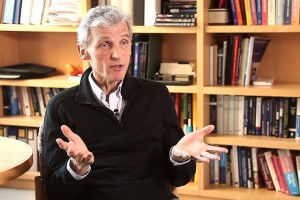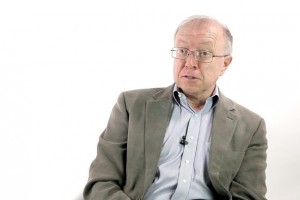Ultracold Atomic Matter as a Field of Study
Physicist Wolfgang Ketterle on quantum simulation, atomic Lego pieces, and evaporative cooling
Which methods are used for cooling molecules down to microkelvin temperatures? What is the difference between classical computer and a quantum one? Professor of Physics at Harvard University John Doyle explains how to use coupled moleculs in quantum computation.
There is an entirely different way of thinking about computation and that is from my quantum-mechanical perspective, not classical anymore but quantum-mechanical. And it was shown fairly recently about 15-20 years ago that there are certain kinds of problems that you can approach using a quantum computer that you can’t approach using a classical computer. So there’s, for example, trying to optimize a path that a traveling salesman takes starting off in one city and he has to visit many of these different cities until he gets to a final city. The question is which path does he take, he or she take to minimize the amount of time that is spent on the trip? And that turned out to be a very hard problem that computational complexity, the amount of time it takes to compute that goes up very, very quickly given as a function of the number of cities involved.
Research is going in the following direction, where I can take these molecules and I simply put them next to each other and that naturally couples them. The way that they’re coupled is through the electric dipole moment. So here’s an electric dipole and it has an electric field like so, here’s another electric dipole that has an electric field and these fields interact and so that means there’s an energy difference between states.
We take a very cold gas of helium, the helium gas collides with the molecule and that brings it down to, well, it sounds cold but it’s one kelvin. So one kelvin is minus two hundred and seventy three degrees Celsius. So we get the molecules around that temperature and now the question is how do we get them colder than that? And the work that’s being currently pursued is to laser cool them. We cool them to around one kelvin by scattering with helium and that works very well and now a number of groups including ours is trying to create a gas of molecules that are in the microkelvin temperature range. And we do that by instead of scattering helium, we scatter photons, we take a laser beam and shine a particular kind of laser light on the molecules and the molecules will absorb the laser light and then remit the laser light and that turns out to give the molecules a little kick and we can arrange things so that kick is always in the direction opposite the way they’re going. And this will lower their velocity, lower their kinetic energy and cool the molecules.

Physicist Wolfgang Ketterle on quantum simulation, atomic Lego pieces, and evaporative cooling

Institute for Advanced Study Prof. Scott Tremaine on the universal law of gravity, predictability and chaos in...

Electric vehicles, metal-based fuel, and the electrolysis method